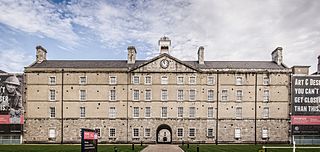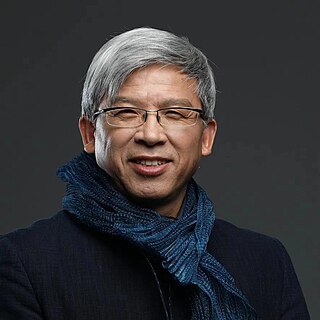Related Research Articles
Costume is the distinctive style of dress or cosmetic of an individual or group that reflects class, gender, profession, ethnicity, nationality, activity or epoch. In short costume is a cultural visual of the people.

Christian Marie Marc Lacroix is a French fashion designer. The name may also refer to the company he founded.

A living museum, also known as a living history museum, is a type of museum which recreates historical settings to simulate a past time period, providing visitors with an experiential interpretation of history. It is a type of museum that recreates to the fullest extent conditions of a culture, natural environment or historical period, in an example of living history.

The Royal Botanic Garden Edinburgh (RBGE) is a scientific centre for the study of plants, their diversity and conservation, as well as a popular tourist attraction. Founded in 1670 as a physic garden to grow medicinal plants, today it occupies four sites across Scotland—Edinburgh, Dawyck, Logan and Benmore—each with its own specialist collection. The RBGE's living collection consists of more than 13,302 plant species, whilst the herbarium contains in excess of 3 million preserved specimens.

The Ulster Museum, located in the Botanic Gardens in Belfast, has around 8,000 square metres of public display space, featuring material from the collections of fine art and applied art, archaeology, ethnography, treasures from the Spanish Armada, local history, numismatics, industrial archaeology, botany, zoology and geology. It is the largest museum in Northern Ireland, and one of the components of National Museums Northern Ireland.

Dame Zandra Lindsey Rhodes,, is an English fashion and textile designer. Her early education in fashion set the foundation for a career in the industry creating textile prints. Rhodes has designed garments for Diana, Princess of Wales and numerous celebrities such as rock stars Freddie Mercury and Marc Bolan. She has also designed textiles for interiors, featuring her prints on furniture and homewares. In 2003 Rhodes founded the Fashion and Textile Museum in London.

The Yorkshire Philosophical Society (YPS) is a charitable learned society which aims to promote the public understanding of the natural sciences, the social sciences, and the archaeology and history of York and Yorkshire.

James Laver, CBE, FRSA was an English author, critic, art historian, and museum curator who acted as Keeper of Prints, Drawings and Paintings for the Victoria and Albert Museum between 1938 and 1959. He was also an important and pioneering fashion historian described as "the man in England who made the study of costume respectable".

Richard Martin was an American scholar, lecturer, critic and curator, and a leading art and fashion historian. At the time of his death he was curator of the Costume Institute at the Metropolitan Museum of Art, creating many critically acclaimed exhibitions and contributing widely towards publications on the subject. After his death, an award in his name was set up to recognise creative, high quality and innovative costume exhibitions.

The Centre for Computing History is a museum in Cambridge, England, established to create a permanent public exhibition telling the story of the Information Age.

Doron Swade MBE, born 1944, is a museum curator and author, specialising in the history of computing. He is especially known for his work on the computer pioneer Charles Babbage and his Difference Engine.

The National Museum of Ireland – Decorative Arts and History is a branch of the National Museum of Ireland (NMI) located at the former Collins Barracks in the Arbour Hill area of Dublin, Ireland.

A textile conservator is a conservator-restorer charged with the care, treatment, research, and preservation of textiles. Issues addressed by a textile conservator are generally related to the field of textile preservation, and include damage caused to textiles by: light, mold and mildew, insects, cleaning, surface cleaning, washing, mounting for display, and storage. Variations in textile types and "the diversity of the textile conservator's work makes it a very rewarding profession". Textiles are among the most fragile artifacts, as they are susceptible to damage from atmospheric pollutants, moisture, biological organisms, and environmental changes and care varies with size, shape, material, and condition issues, all of which a textile conservator must be well versed.
Janet Arnold was a British clothing historian, costume designer, teacher, conservator, and author. She is best known for her series of works called Patterns of Fashion, which included accurate scale sewing patterns, used by museums and theatres alike. She went on to write A Handbook of Costume, a book on the primary sources on costume study, and Queen Elizabeth's Wardrobe Unlock'd, as well as many other books.
Amber Jane Butchart is a British fashion historian and writer. She has researched and appeared in programmes on the BBC, Channel 4, and Sky Arts. In 2018, she presented the BBC documentary series A Stitch in Time. Butchart teaches at London College of Fashion, and consults with the British police as a forensic garment analyst. She has also published several books on fashion history.

The China National Silk Museum is a national-level museum in Hangzhou, Zhejiang province, China.

Dr. Zhao Feng is a Chinese textile specialist with a special interest in Silk Road textiles. Dr. ZHAO has been devoted to working in China National Silk Museum for more than 30 years, and become the Director of China National Silk Museum (NSM) since 2009. His research interests mainly focus on interdisciplinary research on textiles and cultural exchange along the Silk Roads. In his tenure, he has transformed the NSM into a leading center for the preservation, study, and appreciation of silk as a significant art medium, and has developed the museum as a “research-oriented, conservation-cycled, international-targeted and fashion-conscious ” institution.
Claudia Brush Kidwell is a costume historian and former curator at the Smithsonian Institution at the National Museum of American History in the Division of Social History, primarily in the Costume Collection. She served as the first and only female acting director at the Museum of History and Technology in 1979.
Anne Buck was a British cultural historian and curator of dress, who established the Gallery of Costume at Platt Hall in Manchester. She was a leading scholar of dress, who was a founder member and long-time chairman of the Costume Society, and author of many books and papers on the history of dress. She was described as "a towering presence, her contribution to her subject matched by only a handful of outstanding individuals world-wide in the twentieth century".
Phillis Emily Cunnington was an English medical doctor and collector, writer and historian on costume and fashion. She and her husband Cecil Willett Cunnington (1878–1961) worked together not only in their medical practice but also on their collection and writing. In 1947 the Cunningtons' extensive costume collection was acquired by the Manchester City Art Gallery and the Gallery of Costume at Platt Hall was opened.
References
- ↑ "The Costume Society, registered charity no. 262401". Charity Commission for England and Wales.
- ↑ "The Costume Society". History Today. 43 (8). August 1993.
- 1 2 "Costume Society - Our history". The Costume Society. Retrieved 30 March 2019.
- ↑ History of the Costume Society, Costumesociety.org.uk
- ↑ "Costume: the journal of The Costume Society". The Costume Society. Retrieved 30 March 2019.
- ↑ "Events archive". The Costume Society. Retrieved 30 March 2019.
- ↑ The Patterns of Fashion Award, costumesociety.org.uk
- ↑ The Patterns for Performance Award, Costumesociety.org.uk
- ↑ "Our Conservation Awards and Benefactors". The Costume Society. Retrieved 30 March 2019.
- ↑ The Museum Work Experience Grant, Costumesociety.org.uk
- ↑ The Yarwood Research Grant, Costumesociety.org.uk